As the world races toward hyperconnectivity with 5G networks and smart everything, one silent casualty continues to go unnoticed — the soil beneath our feet. While most conversations about electromagnetic radiation (EMR) focus on human health or biodiversity loss, emerging research indicates that our planet’s most fundamental ecosystem, soil, is also being profoundly altered by wireless radiation.
We tend to think of soil as static, but it’s anything but. Soil is a living matrix, teeming with microorganisms that orchestrate everything from plant growth to carbon storage. And yet, this vibrant system is being exposed to levels and frequencies of EMR never before experienced in Earth’s history.
EMR and Soil: What the Science Is Now Showing
While EMR is often discussed in the context of human health, its effects on the ground beneath us are equally critical — and often more overlooked. New research is beginning to unravel how radiation is transforming the biology and chemistry of soil itself.
Disruption of Plant and Soil Systems
According to a 2024 review by the Institute of Soil and Environmental Sciences, electromagnetic radiation can disrupt key agricultural functions by:
Inhibiting photosynthesis and photomorphogenesis in plants
Altering soil water dynamics, including moisture retention and ionic composition
Disrupting microbial enzyme activity, diversity, and symbiotic relationships critical for nutrient cycling
These changes are not minor. They directly influence soil fertility, food security, and the broader health of the planet.
Mechanisms of Harm
The Institute of Soil and Environmental Sciences’ paper outlines that EMR — particularly in high-frequency bands like those used in 5G — interferes with:
Cellular and molecular signaling
Membrane potential in microbial and plant cells
Reactive oxygen species (ROS) balance, increasing oxidative stress
These biological stressors compromise the ability of plants and microbes to function normally. Oxidative stress, in particular, has cascading effects on metabolism, immunity, and regeneration.
What About High-Dose Radiation?
The effects of high-dose radiation offer a critical lens through which we can better understand what continuous low-dose exposure — like that from 5G — might do over time. Soil is one of the most biodiverse ecosystems on the planet, and radiation stress doesn’t just kill microbes; it reshapes entire ecosystems from the ground up.

While 5G uses non-ionizing radiation, studies on ionizing radiation (like gamma rays) offer insight into how even soil microbial communities adapt — or fail to adapt — under persistent EMR stress.
An eye-opening 2019 study in Scientific Reports exposed soil samples to varying levels of gamma radiation and found:
Decline in total bacterial diversity with increasing radiation dose
Unexpected increases in fungal and algal diversity, possibly due to reduced microbial competition
Shift in dominant microbial phyla from Proteobacteria to radiation-tolerant groups like Deinococcus-Thermus and Chloroflexi
Reduction in total nitrogen (TN) and total organic carbon (TOC) in high-radiation soils, indicating weakened soil fertility
Functional Gene Diversity: A Surprising Outcome
Perhaps the most counterintuitive finding? While taxonomic diversity decreased under radiation, functional gene diversity increased — particularly genes associated with:
Dormancy and sporulation (survival strategies)
DNA repair
Stress response
In other words, while fewer types of microbes survived, those that did may have activated more sophisticated tools to deal with stress. This doesn’t mean the ecosystem was healthier — it means it was scrambling to survive.
What This Means for 5G and Agricultural Lands
Unlike gamma radiation, which is delivered in high doses intermittently, 5G and other wireless signals bathe the environment continuously. Even at low levels, this constant EMR exposure may act as a chronic stressor — nudging soil systems into prolonged states of dysregulation.
Interference With Water Dynamics
The Institute of Soil and Environmental Sciences’ research highlighted changes in soil water retention and transpiration rates. Water is a central player in nutrient transport and microbial life. Subtle disruptions in water dynamics can reverberate across an entire ecosystem.
Soil Is Not a Shield — It’s a Sponge
5G radiation doesn’t just stop at the skin of the Earth. Studies suggest that EMR penetrates soil to varying depths, depending on the frequency and intensity. This means:
Root systems may be exposed
Soil enzymes and microbes, particularly in upper layers, may be compromised
Long-Term Implications: The Domino Effect
 Soil doesn’t function in isolation. It’s the base layer of our ecological pyramid — supporting plants, animals, and microbial systems that sustain life. When this base begins to fracture under chronic EMR stress, the impacts move upward — affecting everything from crop yields to atmospheric carbon levels.
Soil doesn’t function in isolation. It’s the base layer of our ecological pyramid — supporting plants, animals, and microbial systems that sustain life. When this base begins to fracture under chronic EMR stress, the impacts move upward — affecting everything from crop yields to atmospheric carbon levels.
A compromised soil microbiome has far-reaching consequences:
Poor plant growth due to weakened nutrient cycling
Increased vulnerability to drought from disturbed water retention
Less carbon sequestration, worsening climate change
Reduced resilience to disease and pests, as microbial symbiosis collapses
In short, what begins as subtle radiation exposure can cascade into full-blown agricultural and ecological instability.
How to Respond: Mitigation and Regeneration
Even in a world drenched in wireless signals, there are ways to push back. Here’s how we can start to soften the blow of EMR on soil life and rebuild what’s been disrupted.
1. Shielding and Buffering
While we can’t eliminate wireless signals from the environment, we can adopt strategies to reduce their impact on soil:
Use of natural EMR shields: Stone walls, clay barriers, and dense vegetation can attenuate EMR
No-device zones: Restrict wireless cellular towers near sensitive agricultural zones
Strategic tree planting: Trees and shrubs can act as living EMR buffers while restoring biodiversity
2. Soil Fortification
We can also strengthen the soil’s resilience with:
Compost and biochar amendments to support microbial life
Mycorrhizal inoculants to reestablish fungal networks disrupted by EMR
Organic mulch layers to insulate topsoil and moderate moisture
3. Research-Backed Interventions
Emerging proposals also include:
Breeding EMR-resilient crop varieties
Improving irrigation systems to counter altered transpiration patterns
Monitoring soil enzyme activities as early indicators of EMR stress
4. Aires Tech: A Modern Tool for an Ancient Problem
While soil itself can’t wear protection, the devices we use around it can. Aires offers advanced EMF-modulating technology designed to reduce the biological stress caused by wireless radiation. Using fractal-based microprocessors, Aires devices help neutralize chaotic electromagnetic fields emitted by our phones, routers, and even large-scale antennas near farms and gardens.
Imagine a future where regenerative farming combines with EMF protection, shielding not only humans but the very microorganisms that keep our food systems alive. Small, strategic steps, such as placing Aires devices near high-EMF zones or on agricultural equipment, could be part of a larger toolkit to protect soil health in a digital era.
Conclusion: Reclaiming Ecological Wisdom in a Digital World
The studies we’ve discussed make it clear: EMR is not just a human health issue or a matter of tech infrastructure. It is a planetary ecological disruptor, silently reshaping life at the microbial level. While there’s still much to learn about 5G’s long-term effects on soil systems, the current evidence demands caution, further investigation, and a rethinking of how we approach innovation.
If we want sustainable agriculture, resilient ecosystems, and food security in an electrified world, we can’t afford to ignore what’s happening beneath our feet. The solutions are there — but only if we have the courage to implement them before it’s too late.
It’s tempting to see 5G as a marvel of human achievement. But real progress accounts for unintended consequences. We cannot digitize the world at the expense of the soil that sustains it.
As research continues to reveal the invisible effects of EMR on the earth’s most life-giving layers, it’s our responsibility to act with humility, foresight, and courage. The future of food, health, and environmental resilience may depend not on how fast we connect devices — but on how deeply we stay rooted in nature.
Let’s ensure that in our quest for smarter cities, we don’t end up with dead soil.
















